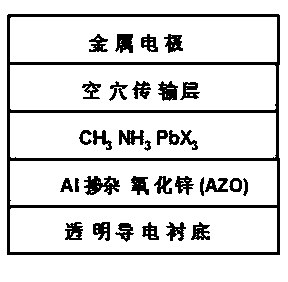Hybrid solar cell with aluminum-doped zinc oxide nanorod as electron transfer layer
A technology of aluminum-doped zinc oxide and electron transport layer, which is applied in circuits, photovoltaic power generation, electrical components, etc., can solve problems such as poor device stability, and achieve low cost, large specific surface area, and high photoelectric conversion efficiency.
- Summary
- Abstract
- Description
- Claims
- Application Information
AI Technical Summary
Problems solved by technology
Method used
Image
Examples
Embodiment
[0032] A hybrid solar cell with Al-doped ZnO nanorods as the electron transport layer, such as figure 1 As shown, it consists of a transparent conductive glass substrate, an electron transport layer, a layered perovskite-like hybrid material, a hole transport layer and an Au metal back electrode layer and sequentially forms a laminated structure. The transparent conductive glass substrate is SnO doped with fluorine 2 (FTO) is a conductive glass with a conductive layer; the electron transport layer is Al-doped ZnO nanorods, the doping concentration is 1.0 mol%, and the thickness is 100nm; the layered perovskite-like hybrid material is CH 3 NH 3 PB 3 , with a thickness of 600nm; the hole transport layer is 2,2',7,7'-tetrakis[N,N-bis(4-methoxyphenyl)amino]-9,9'-spirobifluorene (spiro- MeOTAD), the thickness of the hole transport layer is 40nm; the thickness of the Au metal back electrode layer is 70nm.
[0033] The preparation method of the hybrid solar cell in which the alu...
PUM
 Login to View More
Login to View More Abstract
Description
Claims
Application Information
 Login to View More
Login to View More - R&D
- Intellectual Property
- Life Sciences
- Materials
- Tech Scout
- Unparalleled Data Quality
- Higher Quality Content
- 60% Fewer Hallucinations
Browse by: Latest US Patents, China's latest patents, Technical Efficacy Thesaurus, Application Domain, Technology Topic, Popular Technical Reports.
© 2025 PatSnap. All rights reserved.Legal|Privacy policy|Modern Slavery Act Transparency Statement|Sitemap|About US| Contact US: help@patsnap.com

